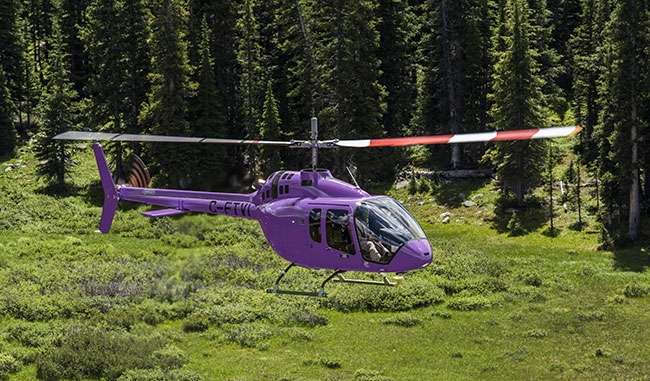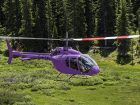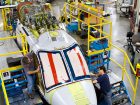
News
Keying in on Innovation
January 26, 2017 By Matt Nicholls
When Mitch Snyder took the podium to address attendees at the Aerospace Industries of Canada (AIAC) 2016 Canadian Aerospace Summit in Ottawa this past November, the president and CEO of Bell Helicopter could easily have delivered a talk about how a sluggish global economy was hindering operations, or how a “take it slow” approach was prudent given difficult market conditions.
 The Bell 505 Jet Ranger is one of four active programs Bell is currently developing. Mitch Snyder took the podium to address attendees
The Bell 505 Jet Ranger is one of four active programs Bell is currently developing. Mitch Snyder took the podium to address attendeesInstead, Snyder delivered a backdoor curveball that was anything but. And while he did stress it’s important to remain responsible and strategic in uncertain economic times, his message was refreshingly robust. Bell is not sitting on its laurels and holding back in terms of innovation and product development, Snyder stressed, quite the contrary. The company is forging ahead with several key programs and choosing to meet challenging times head on.
“As leaders, many of us have felt the pain of reducing our employee base. And while we know it is best for our company’s long-term health, it doesn’t make it any easier,” Snyder noted, referring to staff cutbacks in 2016 due to stagnating market realities brought on by challenges in natural resource sectors such as oil and gas. “Based with tough economic conditions you can hunker down and ride out the storm, or you can pull back expenses across the board. But we are choosing to go another route – we are continuing to invest in our key programs such as the Bell 525 Relentless, the 505 Jet Ranger X and the V280 Valor, our NextGen tilt rotor aircraft. The key to our growth will be to have competitive products when our customers are ready.”
Bell is also aggressively trying to make a splash in the unmanned aircraft space with the introduction in September 2016 of its V-247 Vigilant, an unmanned aerial system (UAS) that combines the vertical lift capability of a rotary-wing aircraft with the speed and range of a conventional fixed-wing aircraft.
The V-247 has a variety of uses in both military and civilian maritime applications.
Bell’s proactive approach to product development means big things for Bell Helicopter Textron Canada’s manufacturing plant in Mirabel, Que.
Bell announced in May 2016 that it was relocating its final assembly line for the 505 Jet Ranger program from Lafayette, La., providing a significant boost to its northern facility that has experienced instability and staff cutbacks over the past few years.
The Mirabel facility is certainly an important one for Bell. In addition to the 505, Mirabel employees are working hard to modernize and develop the Canadian Coast Guard fleet with its new Bell 429 and 412 EPI helicopters. It also continues to support the Royal Canadian Air Force’s (RCAF) Griffon program.
Snyder offered more good news in his address. “We are also laying the groundwork for a new commercial aircraft beyond the 505 and 525 to modernize our entire product line,” he said. “I have committed that Mirabel will be the home for flight test, certification and final assembly for our new next helicopter program.”
Snyder noted that the addition of a new helicopter program in Canada is sure to develop an even stronger supply chain. He specifically made reference to the support he has received from both the provincial and federal governments – relationships he hopes will foster future aerospace growth north of the border.
“I appreciate the support to this sector on both the federal and provincial levels as well as the strategic mindset in terms of global relationships,” he said. “It was personal meetings with Minister Navdeep Bains in Ottawa and Quebec minister Dominique Anglade to make it possible for us to move our 505 production line from the U.S. to Mirabel and secure the long-term future of the plant. That future will be charted for a new focus on innovative solutions and technologies.”
Cynthia Garneau, who replaced Raymond Leduc as Bell Helicopter Canada Textron president in late January of last year, is excited about the developments at the Mirabel site and is confident about future prospects. The Mirabel team has been worked diligently over the last few months to make significant changes to operations to accommodate the new programs.
“The 505 program has its own visionary element and this has been transferred to us,” Garneau told Helicopters at the Helicopter of Association of Canada (HAC) convention and trade show in November 2016. “We have made improvements like the LED lights, custom work stations and work benches – we now have a line with a “world class look.” What is good about the way we are looking at the market, is we are continuing to invest in innovation.”
Bell’s Anthony Moreland, managing director for commercial aircraft in North America, added that while the 505 is a logical fit for the Canadian market, the enhanced northern commitment is as much about the product choice as its history of excellence and prominence in the Canadian market.
“Yes, this aircraft is a solid fit for this market, but I also think it’s the understanding that Mirabel has always been a wonderful facility for us,” Moreland said. “It just make sense from an engineering and manufacturing point of view.”
Expanding the Product Base
While Bell Helicopter Textron Canada is forging ahead with a bevy of programs to be on point with customers when the market warms up, Fort Erie, Ont.-based Airbus Helicopters Canada is following its own unique strategy to remain competitive, productive and innovative in the throes of the current downturn.
Airbus booked eight new helicopters in Canada in 2016, with two new bookings on the horizon, which is on par with 2015. Romain Trapp, president Canada and COO, North America for Airbus Helicopters, told Helicopters that the 2016 sales docket was much more diverse than in previous years – a trend that may just continue.
“What was very interesting about 2016 is the market breakdown,” Trapp noted. “There are a few operators who are indeed focusing on fleet replacement, but it is not as critical as you might think. We received orders from corporate individuals, parapublic and law enforcement. The client base was very diverse and I am expecting 2017 to follow a similar trend.
“In terms of innovation, it is important to remember that while it is more difficult to finance innovate in a downturn market, but it’s also absolutely critical. If you don’t innovate, your leadership is gone. So for us, the H160 program fits this bill; it is just one area of innovation. The program continues to develop with cold-weather testing in Canada in early 2017.
“We are also working on our next generation aircraft, and working to develop an unmanned aerial system based on small helicopters – we see many opportunities for this role, especially for Navy application.”
In addition, Airbus Helicopters Canada made a splash in 2016 with the announcement that it is expanding its facility, adding 5,000 sq. ft. or a 65 per cent boost in space for its expanded maintenance repair and overall (MRO) business, particularly on the popular H125 aircraft.
With a significant increase in both domestic and international MRO demand over the past number of years, Airbus Helicopters Canada is responding to customer demand and altering aspects of its business model.
It is also poised to step up operations in non-helicopter related composite manufacturing, bringing its aerospace quality of manufacturing and ingenuity to other sectors.
“Despite the slow market, the expansion of our facility in Fort Erie last year was a great achievement,” Trapp said. “When I look back three years ago, we have the same number of employees today as we did then – that is an accomplishment in this market. We have been able to achieve this by capturing new business and leveraging the competency of our Fort Erie site to diversify the business on the export side. In the past, we had some 85 per cent of our employees focusing on the Canadian market. Today, it’s close to an even split – 50 per cent on the Canadian market, 50 per cent on the international market.
“We have expanded services for the H125 and also our composite development side of the business. As the New Year develops, we will have even more employees focusing on our diversified business projects. It is a way to grow the business – it’s a strategy that just makes sense.”
And while Trapp is confident market conditions will rebound and return to a more robust state eventually, he isn’t convinced it will be any time soon. It’s not just unique to Canada, either; markets are slow for all OEMs in North America, South America, Europe – with only a few bright sports like China.
“When you look into the future, I don’t see a recovery in the market for at least two years, Trapp said. “We may see some small steps in recovery, but it is very difficult to assess. The main drivers to help create market recovery just aren’t there. The utility market, which is the main driver of commodities, is very low, and oil and gas is sluggish. On the positive side, however, we do see some movement in the EMS markets. But realistically, we are not in a growth market, we are in a replacement situation.”
The “Maytag Repairman” Philosophy
There’s a popular television commercial that made the rounds in the mid- to late 2000s where a Maytag appliance repairman never gets to work on the appliances because they just keep going and going and going.
Much the same situation exists with the Canadian helicopter fleet. It indeed keeps going and going and going, mostly due to the proficiency and resourcefulness of operators to extend the life of aircraft through astute modifications, enhancements and constant improvments.
This resourceful perspective illustrates the ingenuity and creativity of Canadian operators, yes, but it does make it hard on OEMs trying to sell new, state-of-the-art aircraft. Add in the ever prevalent “reluctant to change” philosophy and it makes it hard to gain ground in tough market conditions.
“I don’t think the Canadian market is different than anywhere else,” suggested Enrico Canal, head of region (civil and government) for Leonardo Helicopters. “The operators in Canada are so competitive about what they do, they are so good at enhancing their aircraft and find ways to extend the life of their machines, that it makes it difficult to change attitudes.
“I have also seen a lot of operators take their older aircraft and make them look brand new with a new engine, avionics etc. This is cost effective but not necessarily the best way forward.”
On a global scale, Leonardo is riding the success of its AW family and particularly the AW139, an aircraft of choice for emergency medical, law enforcement and security operators. In 2016, Ontario medical services provider, ORNGE, took possession of an additional AW139 aircraft, boosting the fleet to 20 in Canada.
“The AW139 is a popular product for a lot of companies worldwide and in Canada, where the market requires it to be justified against operational requirements and affordability,” he noted. “It’s a uniquely capable and safe aircraft and this comes at a cost and requires access for operators to appropriate contracts in terms of budget availability and long-term commitment, which is often lacking in Canada, more than in other places. Partially this can be explained by the fact that the Canadian market is primarily a utility market – a single engine market. Most of the contracts are seasonal, so as an operation, you need to have some certainty about what you can do with the aircraft if you are able to invest in this aircraft in the first place.”
With Transport Canada H1 and H2 heliport requirements stating multi-engine aircraft are required, Canal is optimistic Leonardo’s AW139, AW169 and new AW109 Trekker are suitable choices for more EMS providers, or those interested in expanding into the space.
“The AW139 is a trusted machine worldwide, but I have a lot of hope for both the AW109 Trekker, the first AW109 on skids, and the AW009, our newly rebranded light-single engine helicopter introduced at HELI EXPO in 2016. I have had a lot of interest from operators about what they can do. Skids are an important element for the utility element in the Canadian market. It’s all about trying to meet the needs of operators and deliver capable, safe and reliable machines they can depend on.”
Safety No Matter What
As the 2017 operating season looms, Leonardo like other OEMs will continue to remain competitive and innovate in challenging times, while continuing to focus on their collective number 1 goal – deliver the safest operating environment possible.
“I believe there is a lot of room to improve on the safety premise in Canada,” Canal said. “And this does relate to new equipment, because this tends to enhance standards. Think about a well-maintained 30-year-old car and an equivalent brand new one. Both can get you from A to B, but on which one would you prefer your kids to have a ride on? We as OEMs are all working towards that. For example, our latest AW139 and AW169 have HUMS, ADS-B, the latest FAR29 bird strike requirements and more as standards features. We are not going to give you the chance to say no to safety. And there’s a lot more to it than pieces of equipment. There’s an entire new design system and integration. It is on us as OEMs and operators to work to the next level. We can educate customers about the importance of a high safety envelope in addition to higher asset capabilities.
Bell’s Snyder concurs and highlighted at the AIAC conference more positive steps his company is making to ensure innovation, particularly when it comes to enhancing safety, remains paramount.
He also touched on the need for industry to educate the next generation of helicopter professionals to solve the most pressing challenges all operators and OEMs will face.
“Innovative leaders that solve their customers toughest challenges ultimately not only solve their own bottom line, but those of the Canadian economy, and the families and communities throughout the country,” he said. “We are proud to be part of the aerospace fabric in Canada and are committed to the long haul growth despite the current market conditions.”



